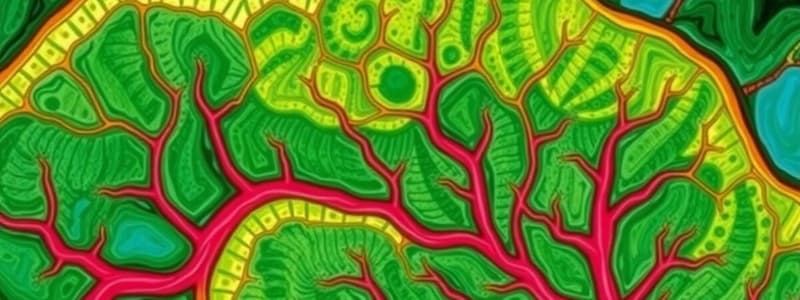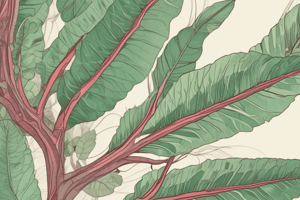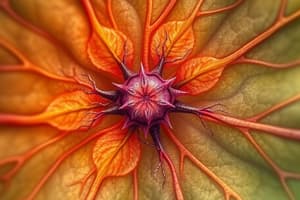Podcast
Questions and Answers
How does the organization of vascular plant tissues into organ systems compare to that of animal tissues?
How does the organization of vascular plant tissues into organ systems compare to that of animal tissues?
- Plant tissues are generally less specialized and do not form distinct organ systems.
- Both plant and animal tissues are organized into organ systems to carry out specific functions, but plant systems are simpler. (correct)
- Animal tissues are primarily focused on nutrient transport whereas plants tissues are focused on structure
- Plant tissues are organized into more complex organ systems than animal tissues.
Which combination of tissues is responsible for providing structural support and transporting nutrients and water throughout a plant?
Which combination of tissues is responsible for providing structural support and transporting nutrients and water throughout a plant?
- Dermal and vascular tissues.
- Vascular and ground tissues. (correct)
- Ground and meristematic tissues.
- Meristematic and dermal tissues.
If a plant is unable to absorb sufficient water from the soil, which of the following root structures is most likely malfunctioning?
If a plant is unable to absorb sufficient water from the soil, which of the following root structures is most likely malfunctioning?
- Xylem
- Stomata
- Trichomes
- Root hairs (correct)
What is the primary distinction between the function of xylem and phloem?
What is the primary distinction between the function of xylem and phloem?
Why is the nervous system essential for maintaining homeostasis in animals?
Why is the nervous system essential for maintaining homeostasis in animals?
Which division of the nervous system is responsible for the 'fight or flight' response?
Which division of the nervous system is responsible for the 'fight or flight' response?
After touching a hot stove, you quickly withdraw your hand. Which neural pathway is primarily involved in this reflex action?
After touching a hot stove, you quickly withdraw your hand. Which neural pathway is primarily involved in this reflex action?
What is the primary significance of the resting membrane potential in neurons?
What is the primary significance of the resting membrane potential in neurons?
How does depolarization differ from an action potential in a neuron?
How does depolarization differ from an action potential in a neuron?
Which of the following describes the 'all-or-none' principle of action potentials?
Which of the following describes the 'all-or-none' principle of action potentials?
Why is repolarization essential for nerve impulse transmission?
Why is repolarization essential for nerve impulse transmission?
What is the primary role of neurotransmitters in the nervous system?
What is the primary role of neurotransmitters in the nervous system?
Which of the following best describes the general functions of the central nervous system?
Which of the following best describes the general functions of the central nervous system?
Why do brain cells have such high requirements for oxygen and nutrients?
Why do brain cells have such high requirements for oxygen and nutrients?
What is the primary role of the somatic nervous system?
What is the primary role of the somatic nervous system?
Which event typically triggers the sympathetic nervous system, and what is one of its primary effects on the body?
Which event typically triggers the sympathetic nervous system, and what is one of its primary effects on the body?
What generally triggers the parasympathetic nervous system, and what effect does it have on the body?
What generally triggers the parasympathetic nervous system, and what effect does it have on the body?
Why do nervous system responses generally occur more rapidly than endocrine system responses?
Why do nervous system responses generally occur more rapidly than endocrine system responses?
Which hormone is directly responsible for regulating the sleep-wake cycle, and from which gland is it secreted?
Which hormone is directly responsible for regulating the sleep-wake cycle, and from which gland is it secreted?
If blood glucose levels are too high, which hormone is released to facilitate the uptake of glucose by cells, and from which gland is it secreted?
If blood glucose levels are too high, which hormone is released to facilitate the uptake of glucose by cells, and from which gland is it secreted?
Flashcards
Homeostasis
Homeostasis
Maintenance of a stable internal environment in the body.
Meristematic Tissue
Meristematic Tissue
Plant tissue responsible for growth; found at tips of roots and shoots.
Dermal Tissue
Dermal Tissue
Outer protective layer of a plant, like skin.
Stomata
Stomata
Signup and view all the flashcards
Trichomes
Trichomes
Signup and view all the flashcards
Ground Tissue
Ground Tissue
Signup and view all the flashcards
Vascular Tissue
Vascular Tissue
Signup and view all the flashcards
Xylem
Xylem
Signup and view all the flashcards
Phloem
Phloem
Signup and view all the flashcards
The Nervous System
The Nervous System
Signup and view all the flashcards
Central Nervous System
Central Nervous System
Signup and view all the flashcards
Peripheral Nervous System
Peripheral Nervous System
Signup and view all the flashcards
Brain
Brain
Signup and view all the flashcards
Spinal Cord
Spinal Cord
Signup and view all the flashcards
Somatic Nervous System
Somatic Nervous System
Signup and view all the flashcards
Autonomic Nervous System
Autonomic Nervous System
Signup and view all the flashcards
Sympathetic Nervous System
Sympathetic Nervous System
Signup and view all the flashcards
Parasympathetic Nervous System
Parasympathetic Nervous System
Signup and view all the flashcards
Reflex Arc
Reflex Arc
Signup and view all the flashcards
Neuron
Neuron
Signup and view all the flashcards
Study Notes
- Homeostasis is the maintenance of a stable internal environment.
Plant Tissues
- Vascular plant organ systems and tissues handle transport, support, and growth, similar to animal systems, but with different structures.
- Four main types of plant tissues are: meristematic, dermal, ground, and vascular.
- Roots anchor plants, absorb water and nutrients, and sometimes store food.
- Xylem transports water and minerals from roots to other plant parts.
Plant Tissue Types
- Meristematic Tissue: Responsible for growth and development.
- Dermal Tissue: This tissue forms the outer protective layer of a plant
- Ground Tissue: Provides support and storage, and where photosynthesis occurs
- Vascular Tissue: Transports water, nutrients, and minerals throughout the plant.
Structures within Dermal Tissue
- Stomata: Pores in the epidermis of leaves and stems that regulate gas exchange.
- Trichomes: These are small hairs on the surface of a plant that are there for protection.
- Root Hairs: These are extensions of epidermal cells in roots that increase surface area for water and nutrient absorption.
Vascular Tissue Types
- Xylem Transports water and minerals from the roots to the rest of the plant.
- Phloem: Distributes sugars, produced during photosynthesis, from leaves to the rest of the plant.
Plant Organs
- Roots: Anchor the plant, absorb water and mineral and store food.
- Stems: Supports the plant and transports water and nutrients.
- Leaves: Main site of photosynthesis.
The Nervous System
- Critical for maintaining homeostasis through rapid communication and response to stimuli.
- The nervous system is essential for rapid communication and maintaining internal balance.
Central Nervous System (CNS)
- Consists of the brain and spinal cord.
- The main structures of the central nervous system are the brain and spinal cord which integrate and coordinate bodily functions.
- The brain requires high nutrient and oxygen levels due to its intense metabolic activity.
Peripheral Nervous System (PNS)
- Consists of all the nerves outside the brain and spinal cord.
Nervous System Divisions
- Somatic Nervous System: Controls voluntary movements of skeletal muscles.
- Autonomic Nervous System: Regulates involuntary functions
Autonomic Nervous System Branches
- Sympathetic Nervous System: "Fight or flight" responses. Triggers include stress, danger, or excitement, leading to increased heart rate, adrenaline release, and heightened alertness.
- Parasympathetic Nervous System: "Rest and digest" functions. Triggered by relaxation, leading to decreased heart rate, increased digestion, and energy conservation.
Reflex Arc
- A neural pathway that controls a reflex action.
- In dodging a tennis ball, the basic neural pathway involves sensory neurons detecting the ball, interneurons in the spinal cord processing the information, and motor neurons signaling muscles to move.
Neuron Structure and Function
- Neuron: The basic unit of the nervous system
- Dendrite: Receives signals from other neurons.
- Cell Body: Contains the nucleus and organelles.
- Axon: Transmits signals to other neurons.
- Axon Terminal: Forms a synapse with another neuron or target cell
- Schwann Cell: Forms the myelin sheath around axons in the PNS.
- Myelin Sheath: Insulates the axon and speeds up impulse transmission
Impulse Transmission
- Neuron At Rest: Has a resting membrane potential (about -70 mV) due to the distribution of ions across its membrane, which is essential for its ability to transmit signals.
- Depolarization: The membrane potential becomes less negative.
- Involves a change in a neuron's membrane potential, which, if strong enough, leads to an action potential.
- An action potential is a rapid, short-lasting change in the electrical potential across the nerve cell membrane, caused by the movement of ions.
- Repolarization: The membrane potential returns to its resting value, which is important for resetting the neuron after an impulse.
- Threshold Potential: The minimum level of depolarization required to trigger an action potential.
- All-or-None Principle: If the threshold is reached, a full action potential fires; if not, nothing happens.
Synapse
- The junction between two neurons.
- Neurotransmitter: Chemical that transmits signals across a synapse.
- Neurotransmitters transmit signals from one neuron to another at the synapse.
- Acetylcholine: A neurotransmitter involved in muscle contraction and memory.
- Dopamine: A neurotransmitter associated with pleasure and motor control.
- Serotonin: A neurotransmitter that helps regulate mood and sleep.
- Endorphins: Neurotransmitters that act as natural pain relievers.
Brain Regions and Functions
- Cerebrum: Responsible for higher-level cognitive functions
- Cerebellum: Coordinates movement and balance.
- Medulla Oblongata: Controls vital functions like breathing and heart rate.
- Pons: Relays signals between the cerebrum and cerebellum.
- Midbrain: Involved in motor control, vision, and hearing.
- Thalamus: Relays sensory and motor signals to the cerebral cortex.
- Hypothalamus: Regulates body temperature, hunger, and thirst.
- Corpus Callosum: Connects the left and right cerebral hemispheres.
- Meninges: Protective membranes surrounding the brain and spinal cord.
Endocrine System
- Glands secrete hormones directly into the bloodstream.
Hormones
- A chemical messenger produced by endocrine glands and transported in the bloodstream to target cells, for example, insulin regulates blood sugar levels.
Endocrine Glands and Hormones
- Pineal Gland: Secretes melatonin, which regulates the sleep-wake cycle.
- Pituitary Gland: Secretes many hormones.
- Human Growth Hormone: Stimulates growth and cell reproduction.
- Thyroid Stimulating Hormone: Stimulates the thyroid gland
- Antidiuretic Hormone: Promotes water retention by the kidneys.
- Thyroid Gland: Secretes thyroxine and calcitonin.
- Thyroxine: Regulates metabolism.
- Calcitonin: Lowers blood calcium levels.
- The thyroid gland acts like a metabolic thermostat by releasing hormones that control metabolism.
- Parathyroid Gland: Secretes parathyroid hormone, which increases blood calcium levels.
- Adrenal Gland: Located above the kidneys.
- Adrenal Cortex: The outer part of the adrenal gland.
- Cortisol: Regulates stress response and metabolism.
- Aldosterone: Regulates sodium and potassium levels.
- Adrenal Medulla: The inner part of the adrenal gland.
- Adrenaline: Increases heart rate, blood pressure, and energy.
- Pancreas: Secretes insulin and glucagon which regulate blood sugar levels.
glucagon increases blood glucose levels.
- Insulin: Lowers blood glucose levels by promoting the uptake of glucose by cells.
- Ovaries: Produce estrogen and progesterone, which regulate female reproductive functions.
- Testes: Produce testosterone, which regulates male reproductive functions.
Feedback Loops
- Negative Feedback Loop: A process where the end product inhibits its own production, maintaining balance.
Short-Term vs Long-Term Stress Response
- Short-Term: Primarily involves the nervous system (sympathetic).
- Long-Term: Predominantly involves the endocrine system (cortisol).
Nervous vs Endocrine
- Nervous system responses are typically more rapid due to the direct electrical and chemical signaling.
- Endocrine responses are slower but have longer-lasting effects.
Studying That Suits You
Use AI to generate personalized quizzes and flashcards to suit your learning preferences.




